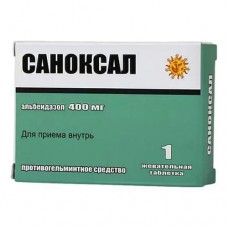Expiration date: 08/2026
Pharmachologic effect
Worming and protivoprotozoynoe means. Selectively inhibit the polymerization of beta-tubulin, resulting in cell destruction cytoplasmic microtubules intestinal helminths biochemical changes during the process (suppressing glucose utilization), blocks the movement of secretory granules and other organelles roundworms muscle cells, causing their death. Most effective against larval forms of cestodes - Echinococcus granulosus and Taenia solium, hookworms - Strongyloides stercolatis.
Pharmacokinetics
Suction
After oral administration is poorly absorbed from the gastrointestinal tract because of poor solubility in water. The drug is rapidly metabolized in the "first pass" through the liver, so the plasma concentration of albendazole in unmodified form are negligible and are not detected. Oral bioavailability is low. However, the simultaneous reception of fatty food absorption and greatly increases the concentration in plasma albendazole (5 times). Albendazole sulfoxide Cmax achieved within 2-5 hours.
Distribution
Plasma protein binding is 70%. Albendazole is well distributed in the body, reaching high concentrations in the urine and the bile, the liver, the wall and the liquid parasitic cysts, cerebrospinal fluid.
Metabolism
Albendazole is rapidly metabolized in the liver with the formation of the primary metabolite - albendazole sulfoxide, also having anthelmintic activity. Albendazole sulfoxide in turn converted to albendazole sulfone (secondary metabolite) and other oxygenated products devoid of pharmacological activity.
Albendazole is an inducer of microsomal enzyme CYP1A2 in human liver cells.
breeding
T1 / 2 albendazole sulfoxide is 8-12 h. The drug is excreted as various metabolites in the urine and the bile, and the renal excretion of small (less than 1%).
Pharmacokinetics in special clinical situations
Against the background of liver damage increases the bioavailability of albendazole. Cmax albendazole sulfoxide increases 2 times, and T1 / 2 longer.
Patients with impaired renal function, clearance of albendazole and its metabolites did not change.
Testimony
- Neurocysticercosis caused by the larval form of the pork tapeworm (Taenia solium),
- Hydatid disease of the liver, lung, peritoneum, caused by the larval form of the dog tapeworm (Echinococcus granulosus),
- Nematosis: ascariasis, trichocephalosis, hookworm, enterobiosis, strongyloidiasis,
- Trematodozy: opistorhoz,
- Some protozoal infections: giardiasis, microsporidiosis,
- Mixed helminthiases,
- As an aid in the surgical treatment of ehinokok cysts.



